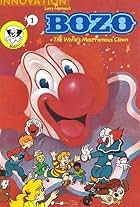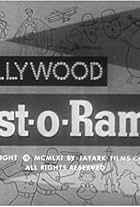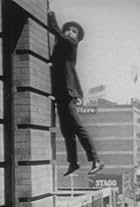Advanced title search
- TITLES
- NAMES
- COLLABORATIONS
Search filters
Enter full date
to
or just enter yyyy, or yyyy-mm below
to
to
to
Exclude
Only includes titles with the selected topics
to
In minutes
to
1-50 of 184
- Children's show. The adventures of Bozo the Clown.
- This syndicated series used still pictures and narration to chronicle the careers of motion picture performers, directors, and producers.
- His father being both a playwright and a deeply religious man would greatly influence the career of Cecil B. DeMille. Growing up in Ethel Lake, New Jersey, Cecil and his brother William would often be told bible stories as they grew up. He is considered a movie making pioneer, creating the Famous Players Corporation, which is better known today as Paramount Pictures and where he made his first motion picture. DeMille helped bridge the gap between the Broadway community and Hollywood, and helped develop what is the star system in Hollywood. Under that star system, DeMille had his stock players. He is probably best known for his religious epics - making both a silent and talkie version of The Ten Commandments (1923) - although he liked to consider himself a dramatist first, and a creator of epics last.
- A brief biography of actor Fred MacMurray: segments include his happy childhood, being discovered by a Broadway group called the California Collegians, and constantly switching between comedic and dramatic roles during his film career.
- A brief but fascinating look at Harold Lloyd's life and career.
- A brief biography of actor John Barrymore.
- The film uses an off-screen narrator and still photographs to breeze through John Wayne's film career. First, he's an extra after playing guard for USC's football team; Raoul Walsh gives him his first screen test and his breakthrough role is in John Ford's "Stagecoach." Then, we get a rapid recitation of starring roles along with photos of him with some of his co-stars -- in Westerns, war films, costume dramas, and a few comedies. By the early 1960's Wayne is an American icon, one of movies' biggest stars.
- A brief biography of actress Judy Garland.
- Starts with childhood photographs of Miss Hepburn and an off-screen narrator's stories of her early abilities to entertain. He then references a brief period in New York when her prickly personality may have cost a job or two, then it's on to Broadway stardom, a contract with RKO, taking Hollywood by storm with unconventional behavior, and winning two Oscars in her first four film roles. The narrator calls her Hollywood's favorite enigma.
- Paul Muni is an actor most known for being able to embody his characters physically as he is almost unrecognizable from role to role. His characters also spanned the ages from young men to old men. Warner Bros. signed him to a contract after the success of his first big role in Scarface (1932). To capitalize on that success, most of Muni's early roles were as tough guys. His portrayals of characters who aged from young to old men are most widely known in The Story of Louis Pasteur (1936) and The Life of Emile Zola (1937), the former which would earn him a Best Actor Oscar. His diverse roles would have him play an East Asian (The Good Earth (1937)) and a Mexican president (Juarez (1939)). In his later professional life, he would divide his time between the silver screen and the Broadway stage.
- Born Rita Cansino in New York, Irish-Latin Rita Hayworth came from show business roots with an actor mother and dancer father. She studied both acting and dancing in her younger years, favoring dancing which provided more opportunity. It was her dancing that got her initially noticed by movie studios. Being cast as nothing more than the eye catching dancer in bit roles, Rita started her rise to stardom by adopting her mother's family name, changing studios and focusing on being a dramatic actress. Once becoming a star, she was able to combine her acting with singing and dancing in movies. Arguably her most famous on-screen moment was as her most iconic role as Gilda (1946) performing the musical number "Put the Blame on Mame". She gave up her acting career to become one of the most famous real life princesses in the world, but returned to acting a few years later.
- James Cagney began his show business career as a dancer. But the movie The Public Enemy (1931) and its famous grapefruit scene with co-star Mae Clarke made Cagney a star as a tough guy women loved and men wanted to emulate. Despite his tough guy screen persona, Cagney was a soft spoken man who prided himself on keeping in good dancing shape. It would come in handy for his second Oscar nominated role as George M. Cohan in Yankee Doodle Dandy (1942), a role which was offered to him directly by the Cohan family and for which he did win the Oscar.
- Jeanette MacDonald's film career is probably best known for her lyrical singing voice. She seemed destined for stardom, even at an early age, as the camera loved her. She started her professional career on Broadway in musical theater. In such productions, she was known primarily as a dancer. She was quickly lured to Hollywood in the early talkie era to star in movie musicals. Her role in The Lottery Bride (1930) would lead to a meeting with opera star Lily Pons, the two would would become friends with and admirers of each other. MGM was the studio which cast her with the person with who she would be forever linked: Nelson Eddy. They were always cast as singing sweethearts. Following her professional association with Eddy, she would instead focus on making public appearances, she being one of the first Hollywood stars to perform for the troops during WWII. Following her permanent retirement from acting in movies, she led a busy life as Mrs. Gene Raymond.
- Known for her beautiful legs, Marlene Dietrich did not choose acting as a first choice of career, but rather concert violinist. Over-practicing resulted in a wrist injury which would deny that first choice. She instead turned to musical theater. Her first international movie hit was The Blue Angel (1930), the costumes for which showed off those famous legs. She and her Blue Angel director Josef von Sternberg moved to Hollywood to collaborate on their next movie, Morocco (1930), which continued her meteoric rise in popularity in America. The studio capitalized on this popularity by casting her in a quick succession of movies, which proved to be a good move for her career. She took a brief hiatus from movie acting in the early 1940's to assist in the war effort, but came back to movie acting as popular as ever.
- Born in Ireland, Greer Garson, known for her screen portrayals of beautiful yet extremely kind and humanistic characters, began her acting career on the London stage, where she was noticed by Louis B. Mayer who signed her to a Hollywood contract. Mayer insisted she not appear in any movie, but the right movie, hence the reason she sat idle for the first year of her contract until the movie Goodbye, Mr. Chips (1939) came along. A string of successful movies followed, including Blossoms in the Dust (1941), which would team her for the first time with who would become her frequent leading man, Walter Pidgeon. A subsequent collaboration with Pidgeon would become her defining screen role as the title character in Mrs. Miniver (1942), for which she would win an Oscar. She was adored by audiences and critics alike, often being voted the screen's most popular actress and being Oscar nominated a number of times following her Miniver win. She made a late career comeback portraying first lady Eleanor Roosevelt in Sunrise at Campobello (1960).
- Photographic stills and an off-screen narrator describe the movie career of English-born Leslie Howard (1893-1943), a stage actor until his first screen appearance at 37. His breakthrough role was "Smiling Through," with Norma Shearer. He continued to go back and forth from Hollywood to England and to work on stage as well as in films - acting, producing, and directing. His female co-stars included several in their first major role. He died over the Bay of Biscayne, his plane shot down by Germans who thought Churchill was on board. His signature style was brains over brawn, embodying the masculine values of self-reliance, courage, and honor.
- Born in Paris, actress Claudette Colbert initially wanted to be a fashion designer. But after a move to the United States and a chance part in a Broadway play, her career path changed. She was cast as the female lead in Paramount Pictures' first ever talkie The Hole in the Wall (1929), which was only her second movie. Despite being cast alongside some of the most sought after leading men of the early 1930's, Claudette's roles were primarily overshadowed by her co-stars. Upon deciding to return to Broadway due to her lack of screen success, the studio began to reinvent her persona as the siren, which paid dividends to her screen popularity. Her title role in Cleopatra (1934) marked the true turning point to her becoming a movie star. Despite many considering Imitation of Life (1934) the crowning glory in her film career, she instead took home the Oscar for Best Actress that year for her comic turn in It Happened One Night (1934), which led to her being known as a versatile actress who could do both dramas and comedies.
- A nearly breathless off-screen narrator and still photographs arranged chronologically take us through the life and career of Errol Flynn (1909-1959). This short film presents him as virile, athletic, and adventurous off screen as well as on. After his youth in Australia and the South Seas, a London screen test sends him to Hollywood. "Captain Blood" is his breakthrough role followed by other swashbuckling parts, often in movies with Olivia de Havilland and Alan Hale. His early death, the narrative suggests, cements his reputation as a Hollywood matinée idol.
- Robert Taylor is known as an actor for his consistency. His global persona belies the fact of being a mid-westerner, born Spangler Arlington Brugh in Nebraska. He got his entertainment start singing in a small ensemble - a trio - in college in Nebraska, they who performed on the local radio. Taylor disbanded the trio to follow his music teacher to California, where he was spotted by a studio representative which led to his start in movies. His starring role in Camille (1936) opposite Greta Garbo shot him quickly to stardom. He starred in one success after another with other A list movie stars. The onset of WWII placed him in one war related movie after another. The war itself would be the cause of a brief hiatus to movies as he went into active duty. He resumed his career as popular as ever, with perhaps his most lauded role as Marcus Vinicius in Quo Vadis (1951).
- A brief profile of the comedy troupe the Marx Brothers, including their origins as classical music performers, their days as stage actors, their break into the movies, and their individual careers after they split up.
- A brief biography of Gregory Peck, including his early childhood ambitions of becoming a shipbuilder, his time in college as an athlete and a pre-medical student, his early theater work, and the films that made him a star.
- Born Laura Gaynor, Janet Gaynor believed since she was a young child that riches and fame were to come her way. Her predetermination seemed to be true as she landed a job as an extra within a week of arriving in Hollywood. She was quickly noticed on the studio lot, which led to a short interview, a short screen test, and the second leading part in a movie. Her rise to stardom was quick, most notably with the presentation of the Academy Awards, being awarded the first ever Best Actress Oscar for a trio of film roles, and her frequent on-screen pairing with Charles Farrell, which the public adored. With Farrell often at her screen side, she made the transition to talkies, including in what was to be the first musical written for the screen, Sunny Side Up (1929). Her pairings with Farrell would abruptly come to an end in the mid 1930's with the merger of Fox and 20th Century Studios, when her contract would not being renewed. However, her second rise to fame as a freelance player would soon come in the starring role in A Star Is Born (1937). She gave up acting shortly thereafter to become the wife of famed Hollywood fashion designer Adrian.
- A brief biography of actor Spencer Tracy.
- 1958–19626mTV-GTV Episode
- 1958–19626mTV Episode
- 1958–19626mTV Episode
- 1958–19626mTV Episode
- 1958–19626mTV Episode
- 1958–19628mTV Episode
- 1958–19626mTV Episode
- 1958–19626mTV Episode
- 1958–19626mTV Episode













